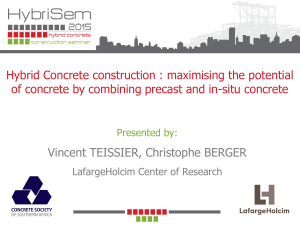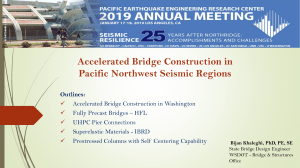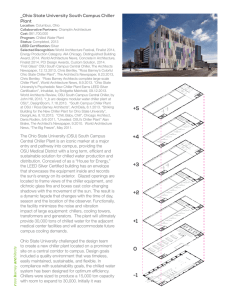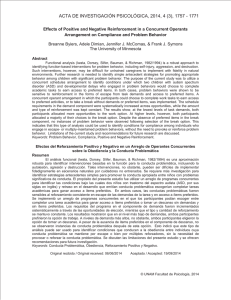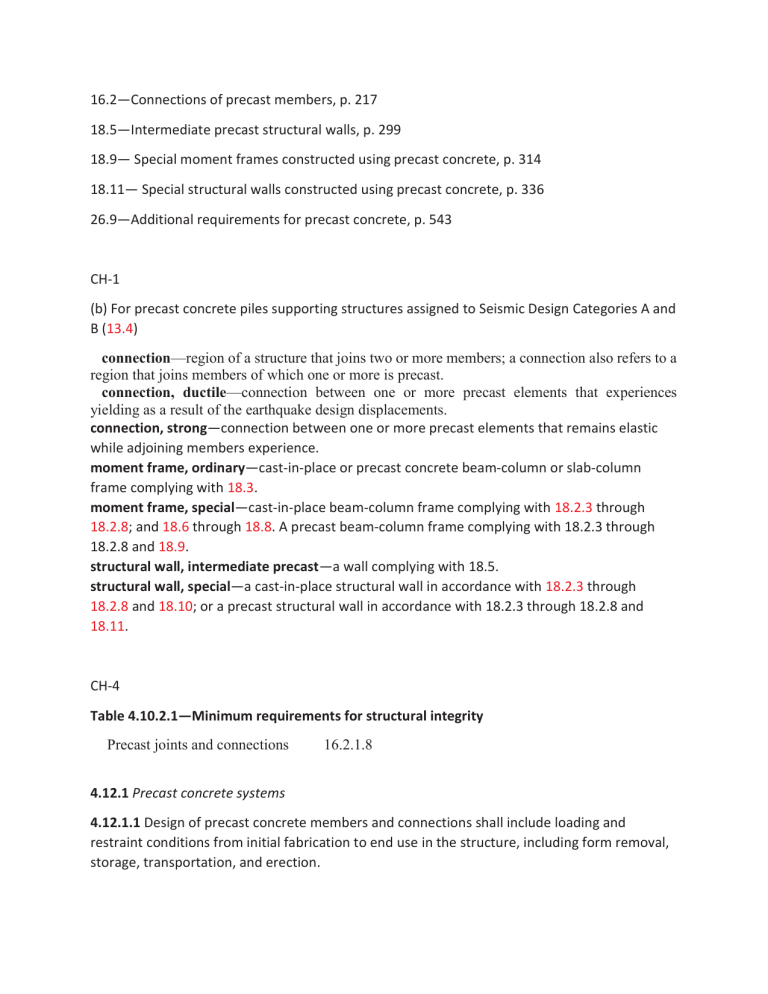
16.2—Connections of precast members, p. 217 18.5—Intermediate precast structural walls, p. 299 18.9— Special moment frames constructed using precast concrete, p. 314 18.11— Special structural walls constructed using precast concrete, p. 336 26.9—Additional requirements for precast concrete, p. 543 CH-1 (b) For precast concrete piles supporting structures assigned to Seismic Design Categories A and B (13.4) connection—region of a structure that joins two or more members; a connection also refers to a region that joins members of which one or more is precast. connection, ductile—connection between one or more precast elements that experiences yielding as a result of the earthquake design displacements. connection, strong—connection between one or more precast elements that remains elastic while adjoining members experience. moment frame, ordinary—cast-in-place or precast concrete beam-column or slab-column frame complying with 18.3. moment frame, special—cast-in-place beam-column frame complying with 18.2.3 through 18.2.8; and 18.6 through 18.8. A precast beam-column frame complying with 18.2.3 through 18.2.8 and 18.9. structural wall, intermediate precast—a wall complying with 18.5. structural wall, special—a cast-in-place structural wall in accordance with 18.2.3 through 18.2.8 and 18.10; or a precast structural wall in accordance with 18.2.3 through 18.2.8 and 18.11. CH-4 Table 4.10.2.1—Minimum requirements for structural integrity Precast joints and connections 16.2.1.8 4.12.1 Precast concrete systems 4.12.1.1 Design of precast concrete members and connections shall include loading and restraint conditions from initial fabrication to end use in the structure, including form removal, storage, transportation, and erection. 4.12.1.2 Design, fabrication, and construction of precast members and their connections shall include the effects of tolerances. 4.12.1.3 When precast members are incorporated into a structural system, the forces and deformations occurring in and adjacent to connections shall be included in the design. 4.12.1.4 Where system behavior requires in-plane loads to be transferred between the members of a precast floor or wall system, (a) and (b) shall be satisfied: (a) In-plane load paths shall be continuous through both connections and members. (b) Where tension loads occur, a load path of steel or steel reinforcement, with or without splices, shall be provided. 4.12.1.5 Distribution of forces that act perpendicular to the plane of precast members shall be established by analysis or test. 4.12.4 Structural plain concrete systems 4.12.4.1 The design of structural plain concrete members, both cast-in-place and precast, shall be in accordance with Chapter 14. CH-7 7.6.3 Minimum shear reinforcement 7.6.3.1 A minimum area of shear reinforcement, Av,min, shall be provided in all regions where Vu > ϕVc. For precast prestressed hollow-core slabs with untopped h > 315 mm, Av,min shall be provided in all regions where Vu > 0.5ϕVcw. 7.7.3.8 Termination of reinforcement 7.7.3.8.1 At simple supports, at least one-third of the maximum positive moment reinforcement shall extend along the slab bottom into the support, except for precast slabs where such reinforcement shall extend at least to the center of the bearing length. CH-9 9.5.4.7 For solid precast sections with an aspect ratio h/bt ≥ 4.5, it shall be permitted to use an alternative design procedure and open web reinforcement, provided the adequacy of the procedure and reinforcement have been shown by analysis and substantial agreement with results of comprehensive tests. The minimum reinforcement requirements of 9.6.4 and detailing requirements of 9.7.5 and 9.7.6.3 need not be satisfied. 9.7.3.8 Termination of reinforcement 9.7.3.8.1 At simple supports, at least one-third of the maximum positive moment reinforcement shall extend along the beam bottom into the support at least 150 mm, except for precast beams where such reinforcement shall extend at least to the center of the bearing length. CH-10 10.7.6.1.6 If mechanical couplers or extended bars for connection to a precast element are placed in the ends of columns or pedestals, the mechanical couplers or extended bars shall be enclosed by transverse reinforcement. The transverse reinforcement shall be distributed within 125 mm of the ends of the column or pedestal and shall consist of at least two No. 13 or three No. 10 ties or hoops. CH-11 11.7.2 Spacing of longitudinal reinforcement 11.7.2.2 Spacing s of longitudinal bars in precast walls shall not exceed the lesser of (a) and (b): (a) 5h (b) 450 mm for exterior walls or 750 mm for interior walls If shear reinforcement is required for in-plane strength, s shall not exceed the smallest of 3h, 450 mm, and ℓw/3. 11.7.3 Spacing of transverse reinforcement 11.7.3.2 Spacing s of transverse bars in precast walls shall not exceed the lesser of (a) and (b): (a) 5h (b) 450 mm for exterior walls or 750 mm for interior walls If shear reinforcement is required for in-plane strength, s shall not exceed the least of 3h, 450 mm, and ℓw/5. CH-12 (b) Diaphragms that comprise a cast-in-place topping slab on precast elements (c) Diaphragms that comprise precast elements with end strips formed by either a cast-in-place concrete topping slab or edge beams (d) Diaphragms of interconnected precast elements without cast-in-place concrete topping. 12.5.2 Moment and axial force 12.5.2.2 It shall be permitted to resist tension due to moment by (a), (b), (c), or (d), or those methods in combination: (a) Deformed bars conforming to 20.2.1 (b) Strands or bars conforming to 20.3.1, either prestressed or nonprestressed (c) Mechanical connectors crossing joints between precast elements (d) Precompression from prestressed reinforcement 12.5.2.4 Mechanical connectors crossing joints between precast elements shall be designed to resist required tension under the anticipated joint opening. R12.5.2.4 In an untopped precast diaphragm resisting in-plane forces and responding in the linear range, some joint opening (on the order of 2.5 mm or less) should be anticipated. A larger joint opening may occur under earthquake motions exceeding the design level. Mechanical connectors should be capable of maintaining design strength under the anticipated joint opening. 12.5.3.5 For diaphragms that are cast-in-place concrete topping slabs on precast elements, (a) and (b) shall be satisfied: (a) Vn shall be calculated in accordance with Eq. (12.5.3.3), and cross-sectional dimensions shall be selected to satisfy Eq. (12.5.3.4). Acv shall be calculated using the thickness of the topping slab for noncomposite topping slab diaphragms and the combined thickness of cast-in-place and precast elements for composite topping slab diaphragms. For composite topping slab diaphragms, the value of fc′ in Eq. (12.5.3.3) and (12.5.3.4) shall not exceed the lesser of fc′ for the precast members and fc′ for the topping slab. (b) Vn shall not exceed the value calculated in accordance with the shear-friction provisions of 22.9 considering the thickness of the topping slab above joints between precast elements in noncomposite and composite topping slab diaphragms and the reinforcement crossing the joints between the precast members. 12.5.3.6 For diaphragms that are interconnected precast elements without a concrete topping, and for diaphragms that are precast elements with end strips formed by either a cast-in-place concrete topping slab or edge beams, it shall be permitted to design for shear in accordance with (a), (b), or both. (a) The nominal strength of grouted joints shall not exceed 0.55 MPa. Reinforcement shall be designed to resist shear through shear-friction in accordance with 22.9. Shear-friction reinforcement shall be in addition to reinforcement designed to resist tension due to moment and axial force. (b) Mechanical connectors crossing joints between precast elements shall be designed to resist required shear under anticipated joint opening. CH-13 Table 13.4.2.1—Maximum allowable compressive strength for deep foundation members Precast nonprestresse d concrete pile Pa = 0.33fc′Ag + 0.4fyAs (d) 16.2—Connections of precast members 16.2.1.1 Transfer of forces by means of grouted joints, shear keys, bearing, anchors, mechanical connectors, steel reinforcement, reinforced topping, or a combination of these, shall be permitted. 16.2.1.2 Adequacy of connections shall be verified by analysis or test. 16.2.1.3 Connection details that rely solely on friction caused by gravity loads shall not be permitted. 16.2.1.4 Connections, and regions of members adjacent to connections, shall be designed to resist forces and accommodate deformations due to all load effects in the precast structural system. 16.2.1.5 Design of connections shall consider structural effects of restraint of volume change in accordance with 5.3.6. 16.2.1.6 Design of connections shall consider the effects of tolerances specified for fabrication and erection of precast members. 16.2.1.7 Design of a connection with multiple components shall consider the differences in stiffness, strength, and ductility of the components. 16.2.1.8 Integrity ties shall be provided in the vertical, longitudinal, and transverse directions and around the perimeter of a structure in accordance with 16.2.4 or 16.2.5. 16.2.2 Required strength 16.2.2.1 Required strength of connections and adjacent regions shall be calculated in accordance with the factored load combinations in Chapter 5. 16.2.2.2 Required strength of connections and adjacent regions shall be calculated in accordance with the analysis procedures in Chapter 6. 16.2.2.3 For bearing connections, Nuc shall be (a) or (b), but need not exceed Nuc,max, where Nuc,max is the maximum restraint force that can be transmitted through the load path of a bearing connection multiplied by the load factor used for live loads in combinations with other factored load effects. (a) For connections not on bearing pads, Nuc shall be calculated simultaneously with Vu using factored load combinations in accordance with 5.3.6. The restraint force shall be treated as a live load. (b) For connections on bearing pads, Nuc shall be 20 percent of the sustained unfactored vertical reaction multiplied by a load factor of 1.6. 16.2.2.4 If the friction coefficient for a bearing material has been determined by results of tests, Nuc,max shall be permitted to be determined by multiplying the sustained unfactored vertical reaction by the friction coefficient and a load factor of 1.6.
